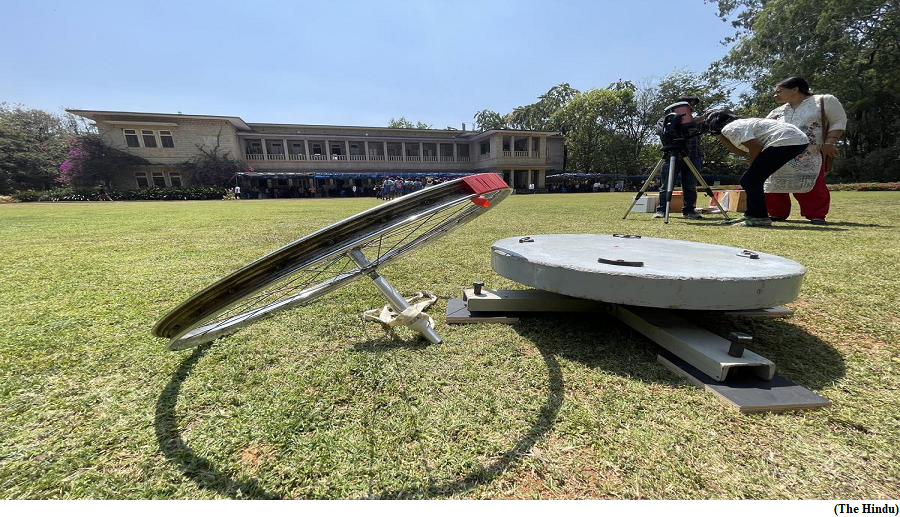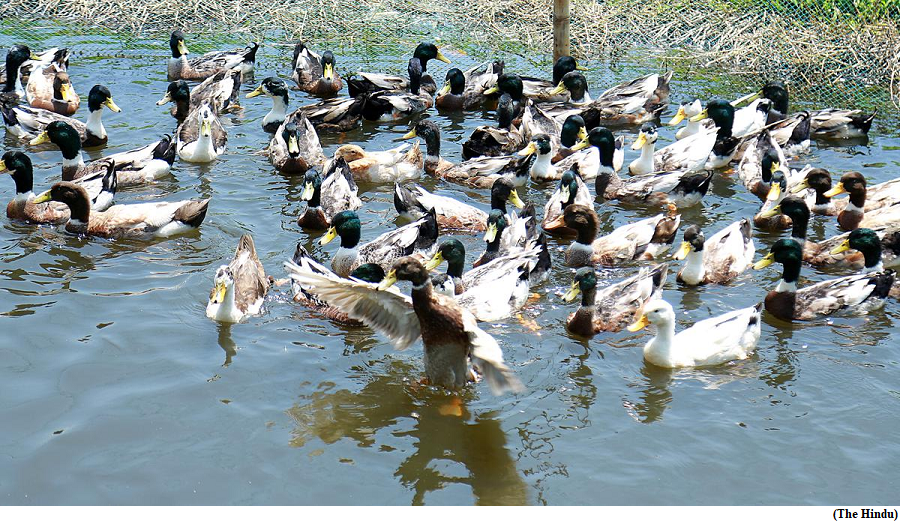Centre plans an ‘overhaul’ of its research institutions (GS Paper 3, Science and Technology)

Why in news?
- The Department of Science and Technology (DST), which is the main source of funds and sustenance for at least 30 autonomous research bodies in the middle of a “rationalisation” exercise that involves merging, “disengaging” and even closure of some organisations.
Details:
- The DST exercise is part of a larger project initiated by the Centre to reduce the number of autonomous institutions funded by various Ministries.
- A high-level committee led by Ratan Wattal, Principal Advisor of NITI Aayog, had undertaken a review of autonomous bodies in 2017.
- In 2023, the DST has budgeted ₹1,225 crore for its autonomous institutions, or a little over 15% of its roughly ₹8,000-crore budget.
Earlier recommendations by Finance Ministry:
- In 2021 that the Finance Ministry recommended 83 of the 231 autonomous bodies to be retained and 117 merged into 29 entities.
- It recommended that the Centre “disengage” from 20 entities. The department also proposed that seven autonomous bodies be closed. After rationalisation is completed, only 111 autonomous bodies would remain.
- With regards to the 30 autonomous bodies (coming under the DST), the Finance Ministry recommended that eight be retained without change, 18 be merged into two, the government disengage from three and one; Vigyan Prasar be wound up and its functions be carried out by the Ministry.
- Vigyan Prasar, an autonomous body set up in 1989 and tasked with science popularisation, is gradually being wound down.
Mergers:
- Among those to be merged, are the Raman Research Institute (RRI), Bangalore founded in 1948 by Sir C.V. Raman and among the country’s top institutes for research into theoretical and high-energy physics, as well as the S.N. Bose National Centre for Basic Sciences and the Bose Institute, both in Kolkata.
- RRI is proposed to be merged with the Jawaharlal Nehru Centre for Advanced Scientific Research, Bangalore, and the latter two Kolkata institutes with the Indian Association for Cultivation of Sciences, also located at Kolkata.
Recent changes:
- The Ministry of Earth Sciences in early 2022 brought its five sister institutes including the India Meteorological Department under a common ‘virtual’ structure but each institute retains its independent identity.
- The Department of Biotechnology merged 14 autonomous institutions under it into an apex body called the Biotechnology Research and Innovation Council (BRIC) in December 2022.
- The 39 laboratories of the Council of Scientific and Industrial Research (CSIR) have, since their inception, been part of a society headed by the Prime Minister of India.
- The Finance Ministry’s rationale behind ‘rationalising’ autonomous bodies in India was that there were nearly 679 autonomous bodies with about half set up as ‘societies’ and 55 set up as trusts and 239 under Acts of Parliament.
Nicobar project violates tribal rights: ST panel
(GS Paper 3, Environment)
Why in news?
- The National Commission for Scheduled Tribes (NCST) has flagged alleged discrepancies with respect to the forest clearance granted for the ₹72,000-crore Great Nicobar Island (GNI) Project.

Details:
- Citing alleged violations under the Forest Rights Act (FRA), 2006, the panel issued notice in April to district authorities on the Andaman and Nicobar islands on grounds that the project will significantly affect the rights of local tribespeople and that the NCST was not consulted.
- Earlier in April 2023, the National Green Tribunal ordered a stay on the project and constituted a committee to revisit the environmental clearance.
Procedural lapses:
- Months after the project was granted forest clearance, implementation reports prepared by the Tribal Affairs Ministry show the island administration neither recognised nor granted ownership of any forest land to tribespeople under the FRA, a requisite step under the Forest Conservation Rules, 2017, before Stage I clearance is granted.
- The clearance was granted in October 2022, two years after the application was received. The project being implemented by the Andaman and Nicobar Islands Integrated Development Corporation includes a transshipment port, airport, power plant and greenfield township.
- The government has said in Parliament that the project intends to use about 7.114 sq. km of tribal reserve forest land, where the Shompen, a Particularly Vulnerable Tribal Group (PVTG), and the Nicobarese reside. It insisted that local people will not be displaced for the project.
- The NCST, in its notice sent this month to the island administration, has sought a detailed action-taken report on the alleged procedural lapses within 15 days.
Role of NCST:
- The Constitution mandated that the government consult the NCST on any matters involving the rights of tribespeople.
- The NCST’s intervention in the project comes even as Tribal Affairs Minister Arjun Munda is currently on a tour of the islands discussing ways to better implement the tribal welfare schemes and oversee the PM-PVTG Mission.
- According to Rule 6(3)(e) of Forest Conservation Rules-2017 (FCR), any diversion of forest land would first require the District Collector to recognise and vest rights to local people under the FRA.
- Only then do the rules permit authorities to seek consent of the now-rights-holding gram panchayats for the diversion of this land, a provision envisioned to give primacy to rights of indigenous forest-dwelling communities.
Timeline of events:
- However, monthly progress reports filed with the Ministry show that the district administration did not receive or process a single claim over forest land under the FRA in the 26-month period between October 2020 and November 2022, even after the clearance was granted.
- Instead, a special Gram Sabha meeting was called for on August 12, 2022, with less than a day’s notice to villagers of Laxminagar, Gandhi Nagar and Campbell Bay panchayats. At this special Gram Sabha, a resolution was purportedly passed, consenting to diversion of the forest land adjacent to their villages for the purpose of the project.
- On August 15, the Sub-Divisional Level Committee at Campbell Bay convened, took a No-Objection Certificate from the Shompen tribespeople through the proceedings, and passed the file to the District-Level Committee. The Shompen were represented in the meeting through the administration’s Andaman Adim Janjati Vikas Samiti (AAJVS).
- Meanwhile, rights bodies and experts argued whether Andaman Adim Janjati Vikas Samiti (AAJVS) could ever truly represent the Shompen, given that it is a society set up and run by the administration.
H5N1 kills 50 million birds, spreads to mammals
(GS Paper 3, Science and Technology)
Why in news?
- In 2023, the world has been witnessing one of the worst-ever documented outbreak of the highly pathogenic avian influenza H5N1 killing millions of birds.
- The virus, which is known to cause severe disease and death in birds, has also been detected in mammalian species and also in humans.
- This has put health authorities on high alert regarding the implications of the large outbreak on public health.

High mortality in birds:
- Although avian influenza has different subtypes, H5N1 is a highly pathogenic subtype that causes mortality in birds.
- Since 2022, the virus has infected over 100 million birds across the globe, resulting in the deaths of over 50 million and culling of millions of poultry.
- Unlike previous outbreaks of highly pathogenic subtypes of avian influenza, H5N1 is heavily impacting wild bird species, including many which were on the verge of extinction.
Impact on wild birds:
- The impact of H5N1 on wild bird populations has varied depending on several factors, such as level of exposure, geographical locations and migratory patterns of the affected species.
- High mortality in wild birds due to the virus could lead to significant ecological consequences, including vulnerability of predators and alterations in species composition in affected ecosystems, and therefore a possible impact on biodiversity not just limited to avian species.
- It has raised concerns regarding the spread of the virus among critically endangered avian populations.
Endangered species:
- The recent reports suggest that at least 20 California condors, a species that was on the verge of extinction since 1980s, have succumbed to H5N1 avian influenza. With around 300 condors estimated to be remaining in the wild, this would roughly account for a significant 7% of the species.
- H5N1 has also killed a large number of bald eagles and Caspian terns in the U.S. since January 2022, along with thousands of cranes in Israel.
- In 2022, H5N1 hit a colony of the endangered African penguins in South Africa, killing at least 30 penguins.
Spread to animals:
- The highly contagious H5N1 virus can also occasionally spillover from birds to animals through direct or indirect contact with infected birds or their droppings.
- Worryingly, there have been several reports on spillover of H5N1 to mammals during the current outbreak from different countries, infecting species such as sea lions, minks, foxes, wild bears, and skunks, apart from domestic animals such as dogs and cats.
- In 2023 alone, H5N1 caused the deaths of over 3,000 sea lions in Peru. In a recent yet-to-be peer-reviewed study, scientists found that the virus could efficiently spread between ferrets in the laboratory.
- The only known cases of the virus spreading between mammals were reported in minks that were raised in close confinement in a farm in Spain.
- The transmission of H5N1 from birds to mammals is rare, but when it does occur, it can be a cause for concern, as the virus could accumulate mutations and acquire the ability to potentially initiate human outbreaks.
Human H5N1 infections:
- H5N1 has a high mortality rate of over 60% in humans and is primarily transmitted to humans through close contact with infected birds or animals, either through handling infected poultry or exposure to contaminated environments.
- In the recent months, a few sporadic cases of human H5N1 infections have also been reported from Ecuador, Cambodia, and more recently in Chile.
- However, since the virus does not yet transmit efficiently among humans, the World Health Organization (WHO) has assessed the risk of H5N1 to humans to be low.
- However, the large and unabated outbreak in avian species and not so rare mammalian spillovers could potentially provide the virus a chance to adapt for mammalian transmission.
Way Forward:
- As the current H5N1 outbreak continues unabated with devastating impact on avian population globally, and with significant ecological and economic consequences, the time has never been better to initiate efforts for preparedness towards building better, efficient vaccines for avians and humans and genomics surveillance to map the continued evolution of the virus.
- Enhanced biosecurity measures are also needed to protect both animal and public health.




